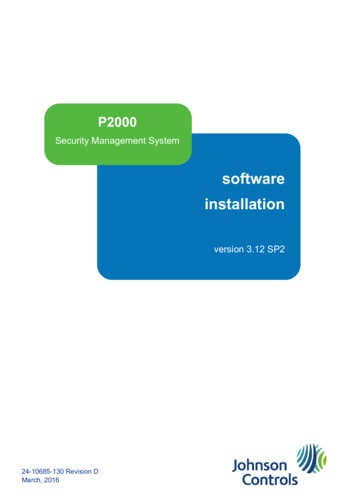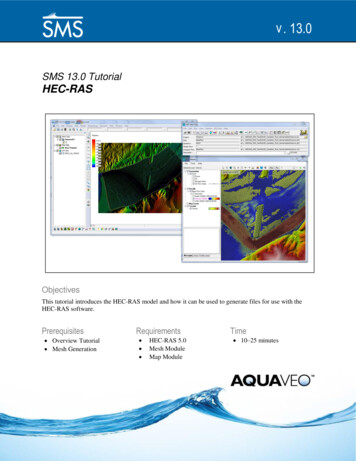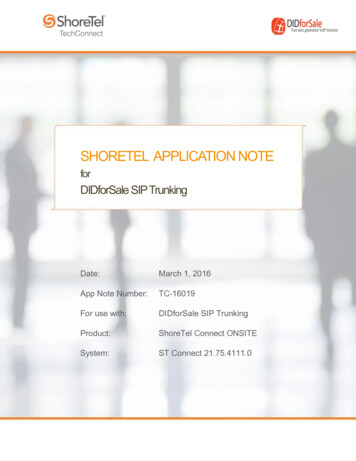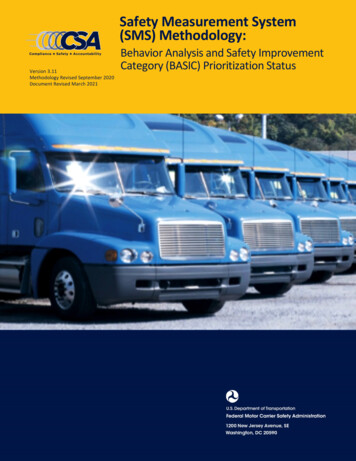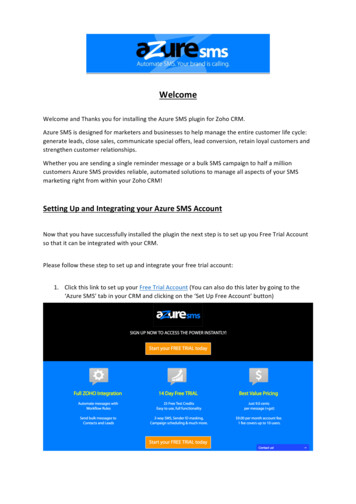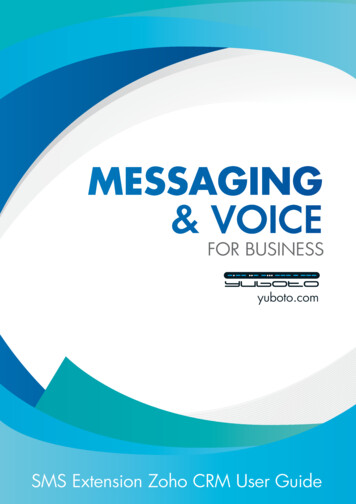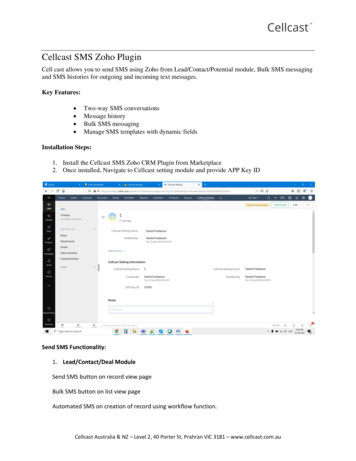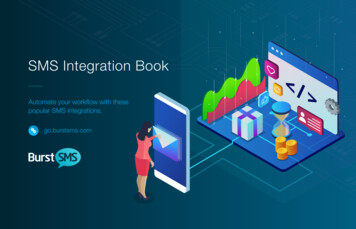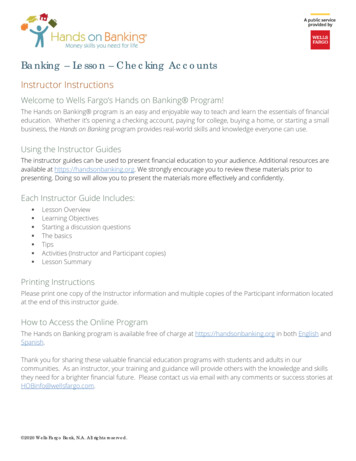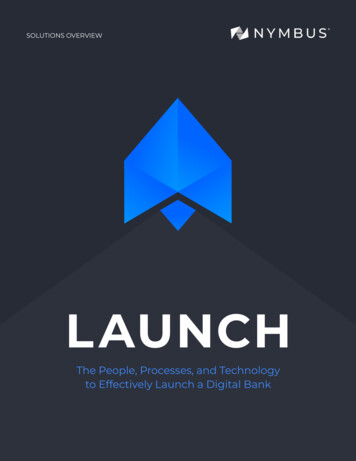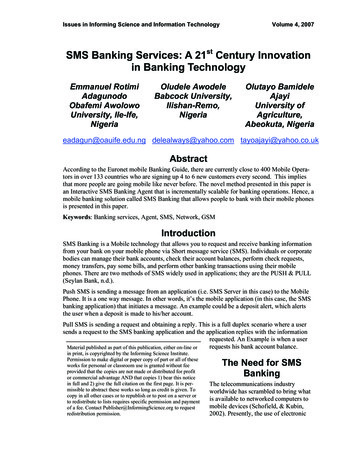
Transcription
Issues in Informing Science and Information TechnologyVolume 4, 2007SMS Banking Services: A 21st Century Innovationin Banking TechnologyEmmanuel RotimiAdagunodoObafemi AwolowoUniversity, Ile-Ife,NigeriaOludele AwodeleBabcock University,Ilishan-Remo,NigeriaOlutayo BamideleAjayiUniversity ofAgriculture,Abeokuta, Nigeriaeadagun@oauife.edu.ng delealways@yahoo.com tayoajayi@yahoo.co.ukAbstractAccording to the Euronet mobile Banking Guide, there are currently close to 400 Mobile Operators in over 133 countries who are signing up 4 to 6 new customers every second. This impliesthat more people are going mobile like never before. The novel method presented in this paper isan Interactive SMS Banking Agent that is incrementally scalable for banking operations. Hence, amobile banking solution called SMS Banking that allows people to bank with their mobile phonesis presented in this paper.Keywords: Banking services, Agent, SMS, Network, GSMIntroductionSMS Banking is a Mobile technology that allows you to request and receive banking informationfrom your bank on your mobile phone via Short message service (SMS). Individuals or corporatebodies can manage their bank accounts, check their account balances, perform check requests,money transfers, pay some bills, and perform other banking transactions using their mobilephones. There are two methods of SMS widely used in applications; they are the PUSH & PULL(Seylan Bank, n.d.).Push SMS is sending a message from an application (i.e. SMS Server in this case) to the MobilePhone. It is a one way message. In other words, it’s the mobile application (in this case, the SMSbanking application) that initiates a message. An example could be a deposit alert, which alertsthe user when a deposit is made to his/her account.Pull SMS is sending a request and obtaining a reply. This is a full duplex scenario where a usersends a request to the SMS banking application and the application replies with the informationrequested. An Example is when a userrequests his bank account balance.Material published as part of this publication, either on-line orin print, is copyrighted by the Informing Science Institute.Permission to make digital or paper copy of part or all of theseworks for personal or classroom use is granted without feeprovided that the copies are not made or distributed for profitor commercial advantage AND that copies 1) bear this noticein full and 2) give the full citation on the first page. It is permissible to abstract these works so long as credit is given. Tocopy in all other cases or to republish or to post on a server orto redistribute to lists requires specific permission and paymentof a fee. Contact Publisher@InformingScience.org to requestredistribution permission.The Need for SMSBankingThe telecommunications industryworldwide has scrambled to bring whatis available to networked computers tomobile devices (Schofield, & Kubin,2002). Presently, the use of electronic
SMS Banking Servicesbanking is considerably high and as more and more users sign up for electronic- banking, thematurity as regards remote banking (i.e. banking outside the banking hall) is on the increase.With electronic banking, users can now conveniently carry out banking transactions, but this convenience cannot be achieved if the user does not have access to the internet, hence, in otherwords, the user cannot carry out a banking transaction while waiting for a bus, or perhaps whilehaving lunch in a restaurant.With SMS banking, convenience can be achieved 24hrs a day. This is because a user has accessto his mobile phone all day, at all times. So, to effectively achieve a truly convenient bankingmode, a truly mobile mode of banking has to be explored, hence the need for SMS Banking.How SMS WorksSMS stands for Short Message Service; it’s a mobile technology that allows for sending and receiving text or even binary messages to and from a mobile phone. The relative ease of use ofSMS makes it possible for a user to learn how to send SMS easily. More than 160 billion SMSare exchanged each month in European countries (Mavrakis, 2004).SMS use the GSM special signaling channel instead of the voice channel and is therefore a veryreliable media channel. MAVRAKIS, 2004 identifies two types of SMS which can be classifiedby the origin of the message Mobile Originated (MO): SMS-MOs’ are sent from a mobile phone and could be senteither to another mobile phone (such when a mobile subscriber sends a personal messageto another subscriber) or to a computer application that will process the message. Mobile Terminated (MT): SMS-MTs’ are transmitted to a mobile phone. They alsocould be sent by another mobile phone or generated by a computer application.The SMS processing computer applications usually runs on corporate servers that are connectedto the SMS network through specialized connectors and gateways connected to the SMS Centersof mobile operators (Mavrakis, 2004).These servers are assigned short numbers instead of the traditional 10-digits mobile numbers.These numbers, also known as short codes are usually 4 to 6 digits long. These numbers are operator specific. Also, a premium fee (a fee other than the fixed rates for SMS) can be charges onthese short codes; in other words, users would pay more for sending SMS to short codes.Data Mining In SMS BankingDue to the large number of users and the large amount of financial transactions expected to becarried out using SMS Banking, there is a need for methodologies of Knowledge Discovery andData Mining (KDD). Data mining is becoming increasingly common in both the private and public sectors. Industries such as banking, insurance, medicine, and retailing commonly use datamining to reduce costs, enhance research, and increase sales (Seifert, 2005).The question to ask now is, “What is Data Mining?” Seifert (2005) defines Data Mining as theuse of sophisticated data analysis tools to discover previously unknown, valid patterns and relationships in large data sets.Hence, the SMS banking application should be able to effectively analyze all banking transactions. If data is successfully analyzed (mined) over a period of time, the bank can develop modelsthat predict whether a customer is a good credit risk, the analysis can also be used to identify illegal money transfers and frauds. There are basically four issues with data mining, they are228
Adagunodo, Awodele, & AjayiData quality: This is a one of the biggest challenges of data mining. Data quality refers to theaccuracy and completeness of the data (Seifert, 2005). Data quality is mostly affected by thestructure and consistency of the data being analyzed. For example, a user might want to check hisaccount balance but mistakenly enters a wrong account number, this would most definitely affectthe result he gets from the SMS banking application.Interoperability: Interoperability refers to the ability of a computer system or data to work withother systems or data using common standards or processes. Hence, it should be possible for anSMS application to use the data gotten from another SMS application.Mission Creep: Mission creep refers to the use of data for purposes other than that for which thedata was originally collected. This happens when account information and financial transactionsare audited against fraud or illegalities.Privacy: This is of great concern because, users’ account information needs to be kept privateand at the same time analyzed.In SMS banking, using data mining techniques, the saving culture of a particular age group can beanalyzed. In other words, it is possible to determine the flow of money, that is, in the month ofFebruary, for example, N 1,000,000 was transferred by people in ages 30 – 65, to people inages 21 – 29. This would imply that a lot of money is being moved from the older generation tothe younger ones.Analysis of the Existing SystemPresently, customers walk in to a banking hall to make transactions, although, these transactionsare automated, their presence is still required; a more convenient banking option is the use ofAutomated Teller Machines (ATMs) as convenient as this method seems to be, the presence ofthis user is still required. Hence, it is obvious that convenience is the major problem of the existing banking system.Aside from the manual system, there are existing electronic banking systems; one of such is theBank Islam, Malaysia which has an SMS Banking System (http://www.bankislam.com). Thissystem allows customers to send SMS to the server and carry out over 30 banking transactionsbut one limitation in this application is that the server is only available for access between 6am to12 pm.The Proposed System – SMS Banking AgentAfter a careful review of the above systems, a system that would “bear the cross” of the users aswell as solve all the identified problems is been proposed. This system is an Interactive SMSBanking AgentThe Banking Agent receives the text messages from the clients, processes them and sends theoutput back to the users when applicable.The proposed system solves all the problems identified in the existing systemThe features of the proposed system are outlined below:1. All phones are capable of sending SMS to it (it is portable)2. Agent runs on a server, hence there’s no need for distribution and deployment3. Agents run real time 24hrs a day, 7days a week4. Users get feedback229
SMS Banking ServicesSystem and Software DesignThe system is separated into hardware and software.HardwareThe hardware required includes (See Figure 1):1. Inbuilt Modem Phone2. Connectivity Cable3. Personal ComputerFigure 1: Hardware Architecture DesignSoftware DesignInput designThe inputs are sent as syntax to the server as a text message, once the server receives the message, it processes it and the output is also sent as a text message back to the client. Below are theinput operations which are sent to the server:230
Adagunodo, Awodele, & AjayiOperations for SMS- Banking: There are a number of transactions that can be carried out usingthe SMS banking agent. They include almost all functions that are presently being performed inthe banking hall. Examples are, creating an account, checking account balances, transferring offunds and changing of pin code.i) Creating an account:To create an account the user has to send“CREATE ACCOUNT Accountname” to the GSM numberwhich is connected to the software. The senders GSM phone number and the account name,which he/she wishes to use, is saved into the database. This module generates an account numberand also a pin code and are both saved into the same database. The account name, account number and pin code are sent back to the user’s number that requested for creation of the account. Thesender receives the message in this format.Account creation successful: Account name: [Accountname] Account number: [account number] PIN: [pin code]ii) Checking account balances:To check account balances or status of the account: The user has to send“CHECK Accountnumber pin code”.This module checks if the user’s account number exists and also checks if the pin code sent alsoexists, if the pin code corresponds with the account number sent, the sender’s account balance issent to his/her GSM phone number which was used to request for the balance. The sender receives the message in this format.Account Balance as at [Date] is N [amount]iii) Transferring of funds:To transfer funds the user has to know the details of who is transferring the funds to like the account number and also the amount he wishes to send, which is also important in making fundstransfer. The user has to sendTRANSFER [senderaccountnumber] [pin code] [Amount] [receipientaccountnumber]The software receives the message checks if the sender’s account details are correct that is theaccount number and pin code, if the account details are invalid the sender is sent a message notifying him/her of what he/she has sent.Account details invalidIt then checks the account if fund is available or enough to perform the transaction if there is notenough funds the sender is sent a message.Your current balance is insufficient to complete the transactionIt then checks the recipient account number whether it exists. If it does not exist the sender receives the message below.Recipient account does not existIf the details for the details for the transaction are correct, the software does the crediting of therecipient’s account and a message that notifies the sender of the transaction that was made and thecurrent balance is sent to the sender, which is below.231
SMS Banking ServicesTransaction Completed, your new account balance is [balance]iv) Changing of pin code:The pin code of an account can be changed if the account owner wishes to change it. The personhas to send a message in this format.CHANGE PIN [accountnumber] [oldpin] [newpin]The sender is notified of the change, and he/she receives a message that saysPin code successfully changedStatement checking: check the statements for one or more accountsPayments: pay for water, electricity, phone or internet invoicesRequest checks: request check booksMobile phone recharging: recharge the mobile phoneStock market operations: perform all types of stock market operationsCredit card operations: pay for credit card debtsDatabase DesignFigure 2: Tables for SMS BankingMy SQL Database is used to store banking information by the agent. It uses three tables for SMSBanking (Figure 2). The tables are:Bank Account: This stores the customer information such as account name, account number,phone number and pinBank Credits: This is used to manage credits for a customer, it is related to the bank account table by the account number field, and hence the foreign key is the account number,Bank Debits: Stores information about debits for a customer, it is also related to the bank account table by the account number field.Advantages and Limitations of SMS BankingAdvantages:1.232Convenience – SMS banking offer
Account creation successful: Account name: [Accountname] Account number: [ac-count number] PIN: [pin code] ii) Checking account balances: To check account balances or status of the account: The user has to send “CHECK Accountnumber pin code”. This module checks if the user’s account number exists and also checks if the pin code sent also
